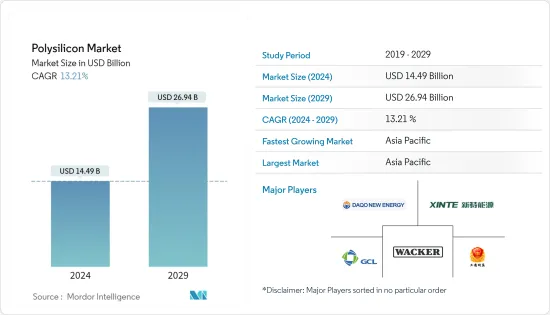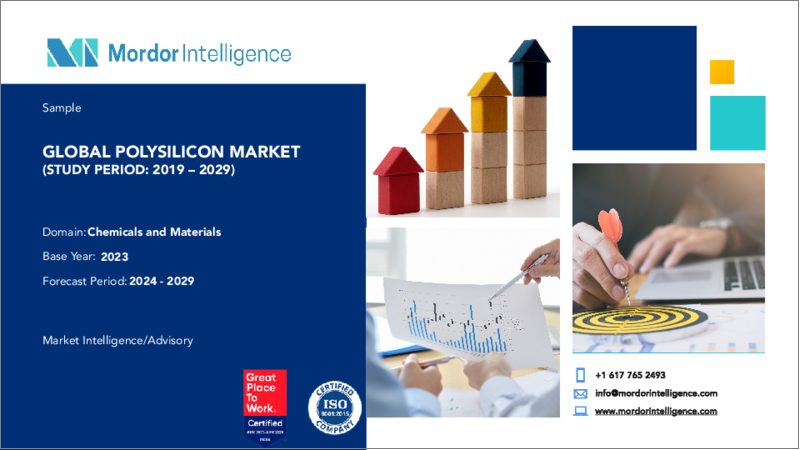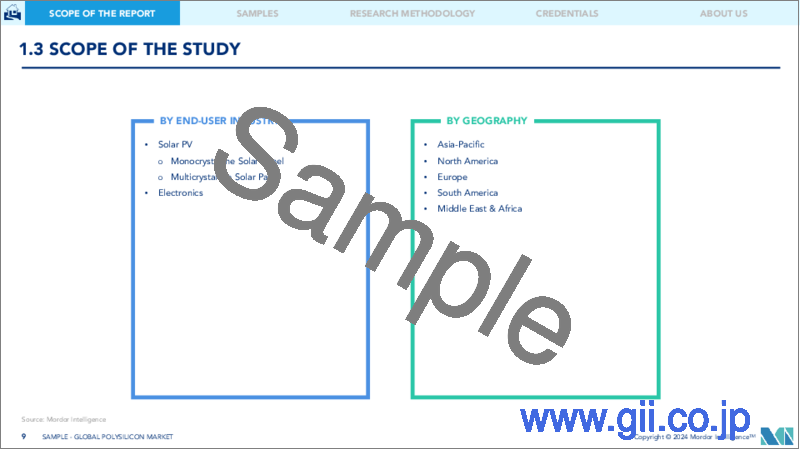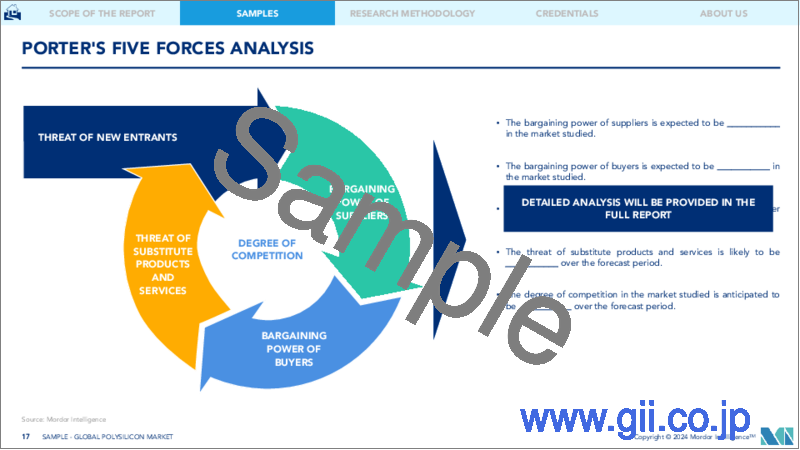|
|
市場調査レポート
商品コード
1439841
ポリシリコン:市場シェア分析、業界動向と統計、成長予測(2024~2029年)Polysilicon - Market Share Analysis, Industry Trends & Statistics, Growth Forecasts (2024 - 2029) |
||||||
|
● お客様のご希望に応じて、既存データの加工や未掲載情報(例:国別セグメント)の追加などの対応が可能です。 詳細はお問い合わせください。 |
|||||||
| ポリシリコン:市場シェア分析、業界動向と統計、成長予測(2024~2029年) |
|
出版日: 2024年02月15日
発行: Mordor Intelligence
ページ情報: 英文 150 Pages
納期: 2~3営業日
|
- 全表示
- 概要
- 目次
ポリシリコン市場規模は2024年に144億9,000万米ドルと推定され、2029年までに269億4,000万米ドルに達すると予測されており、予測期間(2024年から2029年)中に13.21%のCAGRで成長します。

新型コロナウイルス感染COVID-19は、2020年に調査した市場に悪影響を及ぼしました。政府が課したロックダウンを考慮すると、パンデミックの間、世界中の太陽光発電プロジェクトが一時的に停止されました。ただし、調査対象となった市場の需要は2021年に大幅に回復し、今後数年間で大幅な成長が見込まれています。
主なハイライト
- 短期的には、調査対象の市場を推進する主な要因は、太陽光発電(PV)設置数の増加と半導体産業の成長です。
- しかし、改良型冶金級シリコン(UMG-Si)太陽電池や高額な設備投資などの新たな競合他社が市場の妨げとなる可能性が高いです。
- 生産プロセスにおける技術の進歩は、予測期間中に世界のポリシリコン市場において大きな機会となる可能性があります。
- アジア太平洋は世界のポリシリコン市場を独占すると予想されており、中国やインドなどの国の消費増加により、予測期間中に最も急成長する市場になるとも予想されています。
ポリシリコン市場動向
太陽光発電業界の需要の拡大
- ポリシリコンは、シリコンベースの太陽電池の製造に使用される最も重要な原料材料の1つであるため、太陽光発電業界の主要な材料です。
- ポリシリコンは、単結晶ソーラーパネルと多結晶パネルの製造に使用されます。単結晶ソーラーパネルは、現在屋上ソーラーパネル設置に使用されている最も人気のあるソーラーパネルの1つです。単結晶シリコン太陽電池はチョクラルスキー法によって製造されます。この方法では、シリコンの種結晶が高温で純粋なシリコンの溶融槽に入れられます。
- このプロセスでは、インゴットと呼ばれるシリコン単結晶が形成され、これが薄いシリコンウェーハにスライスされ、太陽電池モジュールに使用されます。
- 多結晶パネルは、多結晶パネルと呼ばれることもあります。低予算で太陽光パネルを設置したい住宅所有者に人気です。
- 単結晶パネルと同様に、多結晶パネルはシリコン太陽電池でできています。ただし、冷却プロセスが異なるため、1つではなく複数の結晶が形成されます。住宅で使用される多結晶パネルには、通常60個の太陽電池が含まれています。
- 太陽光発電産業は、世界で最も急速に成長している産業の1つです。国際エネルギー機関(IEA)によると、この産業は世界中の純電力容量のほぼ3分の2を占めています。
- 太陽光発電を使用してミニグリッドに電力を供給することは、特に優れた太陽エネルギー資源を持つ新興諸国において、送電線の近くに住んでいない人々に電力へのアクセスを提供する優れた方法です。
- 太陽光発電は依然として世界で最も急速に成長している再生可能エネルギーであり、国際再生可能エネルギー機関(IRENA)によると、2021年に国際的に設置された再生可能エネルギー3,064 GW(ギガワット)の半分以上を占めています。
- 国際再生可能エネルギー機関(IRENA)によると、2021年の世界全体の太陽光発電容量拡大は19%増加し、133 GWの追加設置を記録しました。さらに、世界経済フォーラムによると、2021年には初めて太陽光発電と風力発電を合わせて世界中の総電力量の10%以上が発電され、そのうち太陽光発電がシェアの約5%を占めました。
- 2021年の世界の太陽光発電総設置容量は、2020年の770 GWに対して約850 GWでした。IEAによれば、2021年の再生可能電力容量の増加は、太陽光発電の新規委託料290 GWによって増加し、その割合は3%に相当します。太陽光発電は、前年の再生可能電力拡大全体の半分以上を占めました。
- したがって、成長する太陽光発電産業により、今後数年間でポリシリコンの需要が高まると予想されます。
アジア太平洋地域が市場を独占
- 中国、韓国、インドなどの国々からの消費が増加しているため、アジア太平洋地域がポリシリコンの主要消費国であることが判明しました。
- 中国省は最近、国内のポリシリコン生産能力を発表したが、その生産能力は合計12万2,000トンだった。
- 国内の新たなポリシリコン拡張のための大規模なパイプラインは引き続き建設されており、2023年までに120万トン以上が稼働すると予想されています。ほとんどの拡張(72%)は新疆以外で計画されているが、世界のポリシリコン生産の大部分(89%)は、今後も中国国内での開催が予想されます。
- 韓国の太陽光発電設備は世界で9番目に大きいです。また、この国は電力の約4%を太陽光エネルギーで生成しており、2021年 11月以降、太陽光発電量は着実に増加しています。さらに、国際貿易機関によると、韓国は2050年までにカーボンニュートラルを達成する14番目の国であり、2030年までに排出量を40%削減するという暫定目標を掲げています。
- 韓国はエネルギー資源の90%以上を輸入しており、国内のエネルギー資源が不足しているため、エネルギー集約度が高いとみなされる産業を支えています。 2021年、韓国は576,316 GWhの電力を発電し、再生可能エネルギー(43,085 GWh)は18%増加しました。
- 2021年、タタ・パワー・ソーラーは、インドで約100MWの複数の分散型地上設置型太陽光発電プロジェクトを立ち上げるため、国営エネルギー効率サービス株式会社(EESL)から538カロールインドルピー(約6,577万米ドル)相当の受注をまとめました。
- 2021年6月現在、世界最大級の太陽光発電施設の多くはインドと中国にあります。インドでは、ラジャスタン州ジョードプル地区にあるバドラ太陽光発電所の総生産能力は2,245メガワットです。
- したがって、このような動向は、エンドユーザーの急速な成長と相まって、予測期間中にアジア太平洋地域の国々でポリシリコンの需要を高めると予想されます。
ポリシリコン業界の概要
世界のポリシリコン市場は統合されており、上位5社が世界生産の大きなシェアを占めています。主要なプレーヤーには(順不同)、Sichuan Yongxiang(Tongwei)、GCL-TECH、DaqoNew Energy、Wacker Chemie AG、XinteEnergyなどがあります。
その他の特典
- エクセル形式の市場予測(ME)シート
- 3か月のアナリストサポート
目次
第1章 イントロダクション
- 調査の前提条件
- 調査範囲
第2章 調査手法
第3章 エグゼクティブサマリー
第4章 市場力学
- 促進要因
- 太陽光発電設置数の増加
- 半導体産業の成長
- 抑制要因
- アップグレードされた冶金級シリコン(UMG-Si)太陽電池などの新たな競合
- 多額の設備投資
- 業界のバリューチェーン分析
- ポーターのファイブフォース分析
- 供給企業の交渉力
- 買い手の交渉力
- 新規参入業者の脅威
- 代替製品やサービスの脅威
- 競合の程度
- 技術的なスナップショット
第5章 市場セグメンテーション(金額ベースの市場規模)
- エンドユーザー産業
- 太陽光発電
- 単結晶ソーラーパネル
- 多結晶ソーラーパネル
- エレクトロニクス(半導体)
- 太陽光発電
- 地域
- アジア太平洋
- 中国
- インド
- 日本
- 韓国
- その他アジア太平洋地域
- 北米
- 米国
- カナダ
- メキシコ
- 欧州
- ドイツ
- 英国
- イタリア
- フランス
- その他欧州
- 南米
- ブラジル
- アルゼンチン
- その他南米
- 中東とアフリカ
- サウジアラビア
- 南アフリカ
- その他中東およびアフリカ
- アジア太平洋
第6章 競合情勢
- 合併、買収、合弁事業、コラボレーション、および契約
- 市場シェア(%)分析
- 有力企業が採用した戦略
- 企業プロファイル
- Asia Silicon(Qinghai)Co. Ltd
- Daqo New Energy Co. Ltd
- GCL-TECH
- Hemlock Semiconductor Operations LLC And Hemlock Semiconductor LLC
- Mitsubishi Polycrystalline Silicon America Corporation
- OCI Company Ltd
- Qatar Solar Technologies
- REC Silicon ASA
- Sichuan Yongxiang Co. Ltd(Tongwei)
- Tokuyama Corporation
- Wacker Chemie AG
- Xinte Energy Co. Ltd
第7章 市場機会と将来の動向
- 生産工程における技術の進歩
The Polysilicon Market size is estimated at USD 14.49 billion in 2024, and is expected to reach USD 26.94 billion by 2029, growing at a CAGR of 13.21% during the forecast period (2024-2029).

COVID-19 negatively affected the market studied in 2020. Considering the government-imposed lockdowns, solar projects across the world were temporarily halted during the pandemic. However, the demand for the market studied recovered significantly in 2021 and is expected to grow at a significant rate in the coming years.
Key Highlights
- Over the short term, the major factor driving the market studied are the increasing number of solar photovoltaic (PV) installations and growth in the semiconductor industry.
- However, emerging competitors, such as upgraded metallurgical-grade silicon (UMG-Si) solar cells and high capital expenditure, are likely to hinder the market.
- Technological advancement in the production process is likely to be a major opportunity in the global polysilicon market over the forecast period.
- Asia-Pacific is expected to dominate the global polysilicon market and is also expected to be the fastest-growing market during the forecast period owing to the increasing consumption of countries such as China and India.
Polysilicon Market Trends
Growing Demand from the Solar PV Industry
- Polysilicon is a key material in the solar PV industry as it is one of the most important feedstock materials used to manufacture silicon-based solar cells.
- Polysilicon is used to produce monocrystalline solar panels and multi-crystalline panels. Monocrystalline solar panels are one of the most popular solar panels used in rooftop solar panel installations today. Monocrystalline silicon solar cells are manufactured through the Czochralski method, in which a seed crystal of silicon is placed into a molten vat of pure silicon at a high temperature.
- This process forms a single silicon crystal, called an ingot, which is sliced into thin silicon wafers, which are then used in solar modules.
- Polycrystalline panels are sometimes referred to as multi-crystalline panels. They are popular among homeowners looking to install solar panels on a budget.
- Like monocrystalline panels, polycrystalline panels are made of silicon solar cells. However, the cooling process is different, which causes multiple crystals to form instead of one. Polycrystalline panels used in residential homes usually contain 60 solar cells.
- The solar PV industry is one of the fastest-growing industries in the world. According to the International Energy Agency (IEA), this industry accounts for almost two-thirds of the net power capacity across the world.
- Using solar PV to power mini-grids is an excellent way to bring electricity access to people who do not live near power transmission lines, particularly in developing countries with excellent solar energy resources.
- Solar power remains the fastest-growing renewable energy across the world, therefore representing over half of the 3,064 GW (gigawatt) of renewable capacity installed internationally in 2021, as per the International Renewable Energy Agency (IRENA).
- According to International Renewable Energy Agency (IRENA), the total global solar capacity expansion increased by 19% in 2021, recording 133 GW additional installations. Furthermore, as per World Economic Forum, in 2021, for the first time, solar and wind together generated over 10% of the total electricity across the world, with solar power accounting for around 5% of the share.
- In 2021, the total global installed solar energy capacity was around 850 GW, compared to 770 GW in 2020. As per IEA, the additions in renewable power capacity in 2021 were driven up by 290 GW of solar PV new commissions, representing a 3% hike from 2020. Solar PV accounted for more than half of the total renewable power expansions the previous year.
- Therefore, the growing solar PV industry is expected to boost the demand for polysilicon in the coming years.
Asia-Pacific Region to Dominate the Market
- Asia-Pacific was found to be the major consumer of polysilicon, owing to increasing consumption from countries such as China, South Korea, and India.
- The Chinese ministry recently released the polysilicon production capacity in the country, which totaled 122,000 tons.
- Sizeable pipelines for new polysilicon expansions in the country continue to be built, with over 1.2 million tons expected to be online by 2023. Although most expansions (72%) are planned outside of Xinjiang, the vast majority (89%) of global polysilicon production is still expected to take place within China.
- South Korea has the world's ninth-largest solar installation. The country also generates about 4% of its electricity from solar energy, and since November 2021, the amount of solar power has been steadily increasing. Furthermore, according to the International Trade Organization, South Korea is the 14th country to become carbon neutral by 2050, with an interim target of reducing emissions by 40% by 2030.
- South Korea imports more than 90% of its energy resources, sustaining industries deemed highly energy-intensive due to its lack of domestic energy resources. In 2021, South Korea generated 576,316 GWh of electricity, with an 18% increase in renewable energy (43,085 GWh).
- In 2021, Tata Power Solar bagged orders worth INR 538 crore (~USD 65.77 million) from state-run Energy Efficiency Services Ltd (EESL) to set up multiple distributed ground-mounted solar projects of approximately 100MW in India.
- As of June 2021, many of the world's largest solar power facilities were located in India and China. In India, Bhadla solar farm, located in Jodhpur district, Rajasthan, has a total production capacity of 2,245 megawatts.
- Hence, such trends, coupled with rapidly growing end users, are expected to boost the demand for polysilicon in countries of the Asia-Pacific region during the forecast period.
Polysilicon Industry Overview
The global polysilicon market is consolidated, with the top five players accounting for a significant share of global production. Some of the major players (not in any particular order) include Sichuan Yongxiang Co. Ltd (Tongwei Co. Ltd), GCL-TECH, DaqoNew Energy Co. Ltd, Wacker Chemie AG, and XinteEnergy Co. Ltd.
Additional Benefits:
- The market estimate (ME) sheet in Excel format
- 3 months of analyst support
TABLE OF CONTENTS
1 INTRODUCTION
- 1.1 Study Assumptions
- 1.2 Scope of the Study
2 RESEARCH METHODOLOGY
3 EXECUTIVE SUMMARY
4 MARKET DYNAMICS
- 4.1 Drivers
- 4.1.1 Increasing Number of Solar PV Installation
- 4.1.2 Growth in the Semiconductor Industry
- 4.2 Restraints
- 4.2.1 Emerging Competitors, such as Upgraded Metallurgical-grade Silicon (UMG-Si) Solar Cell
- 4.2.2 High Capital Expenditure
- 4.3 Industry Value Chain Analysis
- 4.4 Porter's Five Forces Analysis
- 4.4.1 Bargaining Power of Suppliers
- 4.4.2 Bargaining Power of Buyers
- 4.4.3 Threat of New Entrants
- 4.4.4 Threat of Substitute Products and Services
- 4.4.5 Degree of Competition
- 4.5 Technological Snapshot
5 MARKET SEGMENTATION (Market Size in Value)
- 5.1 End-user Industry
- 5.1.1 Solar PV
- 5.1.1.1 Monocrystalline Solar Panel
- 5.1.1.2 Multicrystalline Solar Panel
- 5.1.2 Electronics (Semiconductor)
- 5.1.1 Solar PV
- 5.2 Geography
- 5.2.1 Asia-Pacific
- 5.2.1.1 China
- 5.2.1.2 India
- 5.2.1.3 Japan
- 5.2.1.4 South Korea
- 5.2.1.5 Rest of Asia-Pacific
- 5.2.2 North America
- 5.2.2.1 United States
- 5.2.2.2 Canada
- 5.2.2.3 Mexico
- 5.2.3 Europe
- 5.2.3.1 Germany
- 5.2.3.2 United Kingdom
- 5.2.3.3 Italy
- 5.2.3.4 France
- 5.2.3.5 Rest of Europe
- 5.2.4 South America
- 5.2.4.1 Brazil
- 5.2.4.2 Argentina
- 5.2.4.3 Rest of South America
- 5.2.5 Middle East and Africa
- 5.2.5.1 Saudi Arabia
- 5.2.5.2 South Africa
- 5.2.5.3 Rest of Middle East and Africa
- 5.2.1 Asia-Pacific
6 COMPETITIVE LANDSCAPE
- 6.1 Mergers, Acquisitions, Joint Ventures, Collaborations, and Agreements
- 6.2 Market Share (%) Analysis
- 6.3 Strategies Adopted by Leading Players
- 6.4 Company Profiles
- 6.4.1 Asia Silicon (Qinghai) Co. Ltd
- 6.4.2 Daqo New Energy Co. Ltd
- 6.4.3 GCL-TECH
- 6.4.4 Hemlock Semiconductor Operations LLC And Hemlock Semiconductor LLC
- 6.4.5 Mitsubishi Polycrystalline Silicon America Corporation
- 6.4.6 OCI Company Ltd
- 6.4.7 Qatar Solar Technologies
- 6.4.8 REC Silicon ASA
- 6.4.9 Sichuan Yongxiang Co. Ltd (Tongwei)
- 6.4.10 Tokuyama Corporation
- 6.4.11 Wacker Chemie AG
- 6.4.12 Xinte Energy Co. Ltd
7 MARKET OPPORTUNITIES AND FUTURE TRENDS
- 7.1 Technological Advancement in Production Process




